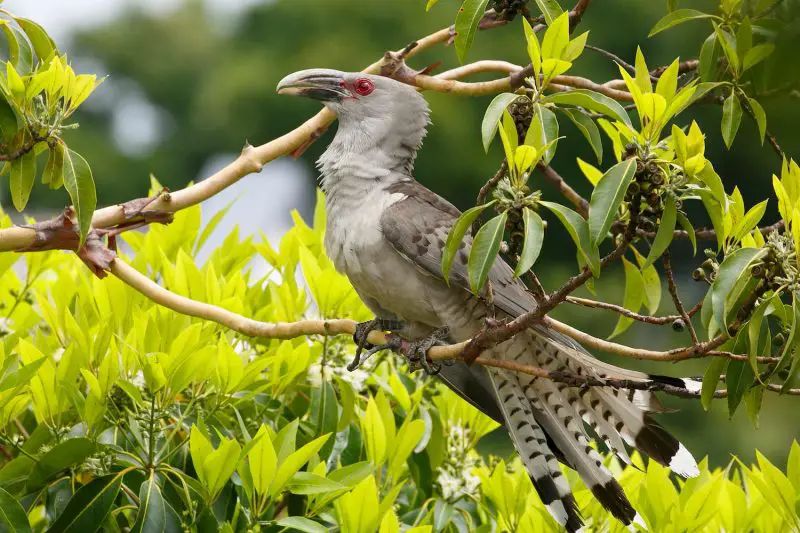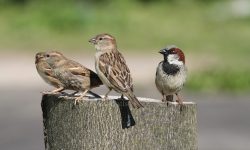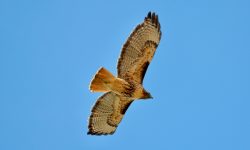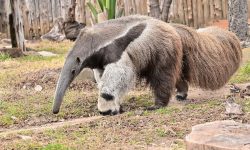The Channel-billed Cuckoo (Scythrops novaehollandiae) doesn’t just turn heads—it demands a double take. With a massive, banana-shaped bill that looks more like it belongs to a toucan than a cuckoo, this bird defies every expectation. Found primarily in Australia and nearby regions, the Channel-billed Cuckoo is the largest parasitic cuckoo in the world—and one of the weirdest-looking birds in the avian kingdom. In this article, we dive deep into the strange anatomy, behavior, and evolutionary logic behind that jaw-dropping beak. Why is it so big? What does it do with it? And how does this bird’s appearance tie into its truly bizarre way of life?

A Beak Unlike Any Other
The Channel-Billed Cuckoo’s Beak: A Tool of Deception, Power, and Drama
Among the world’s most distinctive bird faces, few are as unforgettable—or as mystifying—as that of the Channel-billed Cuckoo (Scythrops novaehollandiae). Towering above most other cuckoos in size, this giant of the cuckoo family is instantly recognizable thanks to one dramatic feature: its beak. Long, scimitar-shaped, and pale ivory-gray, the beak often exceeds 6 centimeters in length and curves downward like a blade from another era. Grooved and laterally flattened, it gives the bird a “channeled” profile that inspired its common name—and adds a sense of prehistoric intensity to its already imposing silhouette.
But this isn’t just a large beak—it’s a statement, a multifunctional adaptation that plays a surprising role in both feeding and manipulation. Unlike the predatory raptors its bill resembles, the Channel-billed Cuckoo is a fruit specialist, not a hunter. Its primary diet consists of rainforest figs, berries, and soft-skinned fruit, which it plucks deftly from high branches using that extended bill like a botanical reach tool. With dense canopies often hiding fruit clusters beyond the grasp of smaller birds, this curved weapon becomes a forager’s dream—helping the cuckoo exploit resources others miss.
Yet the beak’s most evolutionarily cunning use may lie outside feeding altogether. As a brood parasite, this cuckoo lays its eggs in the nests of larger birds—especially crows, currawongs, and magpies. Getting close to these nests without provoking attack requires more than speed or stealth. It demands intimidation. And here, the Channel-billed’s hawk-like profile becomes key. Many host birds perceive the cuckoo’s silhouette—especially that exaggerated, downturned beak—as predatory. The resemblance to a raptor causes hesitation or retreat, buying the female cuckoo just enough time to sneak into the nest and lay her egg.
This isn’t brute force. It’s a visual bluff, an act of evolutionary sleight-of-hand where fear does the work of violence. In this high-stakes performance, the beak becomes both mask and tool, turning mimicry into a parasitic superpower.
How Does It Compare? When a Cuckoo Wears a Raptor’s Mask
To appreciate how unusual this adaptation is, let’s compare it to other birds.
At first glance, the beak of the Channel-billed Cuckoo calls to mind that of raptors—hawks, eagles, or vultures. These birds use their sharply hooked bills to tear flesh, crack bones, and dispatch prey. But look closer, and the differences become clear. A raptor’s beak is compact, thick at the base, and knife-edged for ripping. In contrast, the Channel-billed’s beak is longer, shallower, and less hooked—designed not for aggression, but for access. It’s for reaching, not killing.
You might also compare it to fruit-eating giants like toucans or hornbills. But again, differences emerge. The toucan’s colorful beak is hollow and lightweight, adapted for precise manipulation and thermoregulation. The hornbill’s is often reinforced for smashing or digging. The Channel-billed’s bill, by contrast, is sturdier, denser, and lacks the air-filled structures common in toucans. It seems built as much for visual dominance as for mechanical function.
Even within its own family, the Channel-billed Cuckoo stands apart. Most cuckoos sport modest, slender beaks adapted for snatching insects. The European Common Cuckoo (Cuculus canorus) or Australia’s Pheasant Coucal both look delicate in comparison. No other cuckoo wields its bill with such presence—or such influence.
Evolution’s Boldest Gamble
So why has evolution selected such an exaggerated feature in a frugivorous parasite? The answer lies in the Channel-billed Cuckoo’s high-risk, high-reward lifestyle. Success depends on deception: it must infiltrate the nests of intelligent, aggressive hosts and leave undetected. The beak, combined with its large body size and piercing red eyes, completes the illusion. It says, “Don’t challenge me—I’m dangerous.”
In the world of birds, size and strength can be trumped by psychological advantage. And this cuckoo proves it. Its enormous beak doesn’t just pluck fruit—it plucks opportunity from hesitation, fear, and misjudgment. It’s not just a feeding tool—it’s a social lever, a weaponized illusion, a billboard of power.
The Channel-billed Cuckoo’s beak isn’t strange by accident. It’s strange by design—a masterstroke of natural selection, and perhaps one of the most underrated evolutionary innovations in the cuckoo world.
Where This Odd Bird Lives
A Giant Cuckoo with a Tropical Passport
The Channel-billed Cuckoo isn’t just the largest cuckoo in the world—it’s also one of the most widely traveled. From the tropical rainforests of New Guinea to the sprawling eucalyptus woodlands of eastern Australia, this sky nomad follows the sun across some of the Southern Hemisphere’s wildest and warmest frontiers. Its range stretches across northern and eastern Australia, eastern Indonesia, and southern Papua New Guinea, with seasonal appearances that mark the turning of spring like clockwork. In much of Australia, it is a high-profile migrant, swooping in around September or October to breed, and quietly retreating north as the breeding season ends.
Where Figs Are Plenty, the Cuckoo Will Be
Despite its hulking frame and grating, crow-like voice, the Channel-billed Cuckoo is a master of vanishing in plain sight. It prefers open forests, subtropical woodlands, parks, orchards, and even leafy urban neighborhoods—anywhere ripe with native fruiting trees like figs, mulberries, or native laurels. These towering trees not only provide food but also help conceal the cuckoo’s bulky silhouette. High in the canopy, partially hidden among rustling leaves, the bird becomes more a rumor than a sighting—often heard before it’s ever seen.
What’s even more surprising? These outsized cuckoos are right at home in city gardens, provided the fruit is plentiful and the trees are tall enough. Their mysterious presence in such human-dominated spaces adds to their almost mythical air—ghosts with wings and scimitar beaks, gliding silently into view just before summer thunder breaks.
Brood Parasitism: A Master of Deception
Reproduction by Trickery, Not Tenderness
Forget nest-building, feeding chicks, or singing to attract a mate—the Channel-billed Cuckoo (Scythrops novaehollandiae) takes a completely different route to parenthood. This bird is a brood parasite, one of nature’s most cunning strategists. Rather than raise its own young, the female Channel-billed Cuckoo stealthily lays her egg in the nest of another species, most often unsuspecting Australian ravens, currawongs, or magpies. These intelligent and fiercely territorial birds become unwitting foster parents, investing all their energy into raising a chick that isn’t even theirs.
What makes this even more incredible is the speed and precision of the deception. The female cuckoo watches the host birds carefully, choosing just the right moment—often when the nest is unattended. Then, in a flash lasting mere seconds, she deposits her egg and vanishes. The egg usually mimics the size and color of the host’s own, avoiding detection.
Once hatched, the cuckoo chick grows quickly, outpacing its nest mates in size and strength. It dominates feeding sessions, often pushing the host’s biological chicks aside—or out of the nest entirely. By the time it fledges, the young cuckoo is larger than its adoptive parents, a bizarre sight of misdirected devotion.
The Beak as a Bluff: Intimidation by Design
But how does such a large, noisy bird infiltrate the nest of sharp-eyed, aggressive hosts without triggering attack? Evolution may have handed it the perfect disguise.
The Channel-billed Cuckoo’s massive, downcurved beak, paired with its hawk-like silhouette and piercing screech, creates an unmistakable visual message: “Don’t mess with me.” Researchers believe this fearsome appearance may serve as a psychological weapon—mimicking birds of prey that hosts instinctively fear. Faced with what looks like a predator, host birds may hesitate, retreat, or even freeze, giving the female cuckoo just enough time to slip in and lay her egg unnoticed.
It’s not brute strength or stealth that defines the Channel-billed Cuckoo’s reproductive success—it’s misdirection. This bird doesn’t raise its young—it convinces others to do it, wielding evolution’s most audacious bluff with theatrical flair. In the world of avian deception, the Channel-billed Cuckoo reigns as a master manipulator, proving that sometimes, the sharpest weapon isn’t a talon or claw—but a well-timed illusion.
Diet and Feeding Behavior
Frugivore First, Insect-Eater Second
The Channel-billed Cuckoo is primarily frugivorous, feeding on a wide variety of soft fruits including figs, native plums, and berries. It will also consume insects, caterpillars, and the occasional small vertebrate if needed, especially during the breeding season when protein is in demand. Its large beak may help it pluck fruit from branches other birds can’t access. The bird often feeds high in the canopy and can even hang upside down to reach fruit, showing surprising agility for such a bulky bird.
A Call You Can’t Miss
If you don’t see a Channel-billed Cuckoo, you’ll almost certainly hear one. Its call is raucous, loud, and unmistakably harsh—a repeated, nasal “KAAARK-KAAARK-KAAARK!” often delivered while flying overhead. During breeding season, these calls fill the air in parts of Australia, sometimes prompting locals to describe them as “flying banshees.” The beak may also play a role in vocal resonance, helping amplify these loud calls across forested landscapes.
Migration: From Tropics to Temperate Zones
Each year, Channel-billed Cuckoos migrate thousands of kilometers. Most birds overwinter in New Guinea and eastern Indonesia, then migrate southward to Australia for the breeding season between September and March. These long-distance flights are undertaken solo or in small groups, often at night.
Juveniles: Beak-to-Body Proportions
Young Channel-billed Cuckoos grow quickly and often end up larger than their foster parents. Their beak starts to take on its signature curve and bulk early in development, sometimes making them appear clumsy or top-heavy in the nest.
Conservation Status
Currently, the Channel-billed Cuckoo is listed as Least Concern by the IUCN. It has adapted well to human-altered environments and is expanding its range in some regions thanks to the spread of fruiting trees in suburban gardens. However, as with many migratory birds, it remains vulnerable to habitat loss and climate change, especially in overwintering areas.
Why That Beak Matters
The Channel-billed Cuckoo’s beak is more than just an oddity—it’s a multi-functional tool tied to its feeding ecology, parasitic lifestyle, and evolutionary identity. It may not slice or tear like a hawk’s, but it enables the cuckoo to exploit niches that most birds—cuckoos or otherwise—can’t access. It’s a symbol of what makes this bird so unusual: a massive frugivore with a predator’s profile and a trickster’s heart.
Conclusion: A Bird That Breaks the Mold
From its bizarre appearance to its sneaky reproductive strategy and booming voice, the Channel-billed Cuckoo is a true original. It challenges what we think a cuckoo should look like and behaves in ways that blend mimicry, strategy, and survival. Next time you hear a wild screech echoing through the Australian sky or glimpse a bird that looks like a parrot gone rogue, take a closer look—it just might be the Channel-billed Cuckoo, the bird with a beak you’ll never forget.






